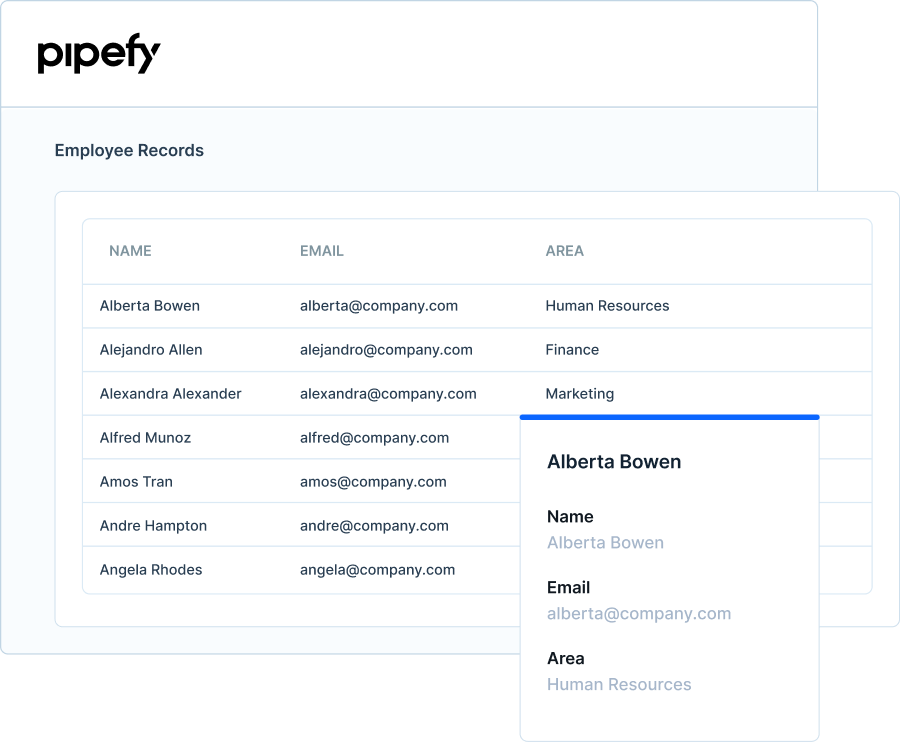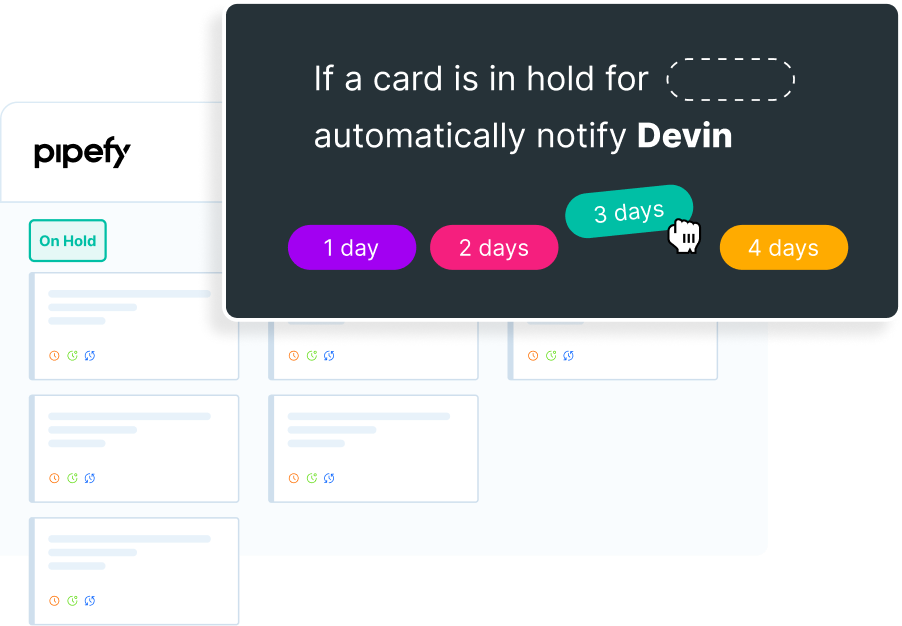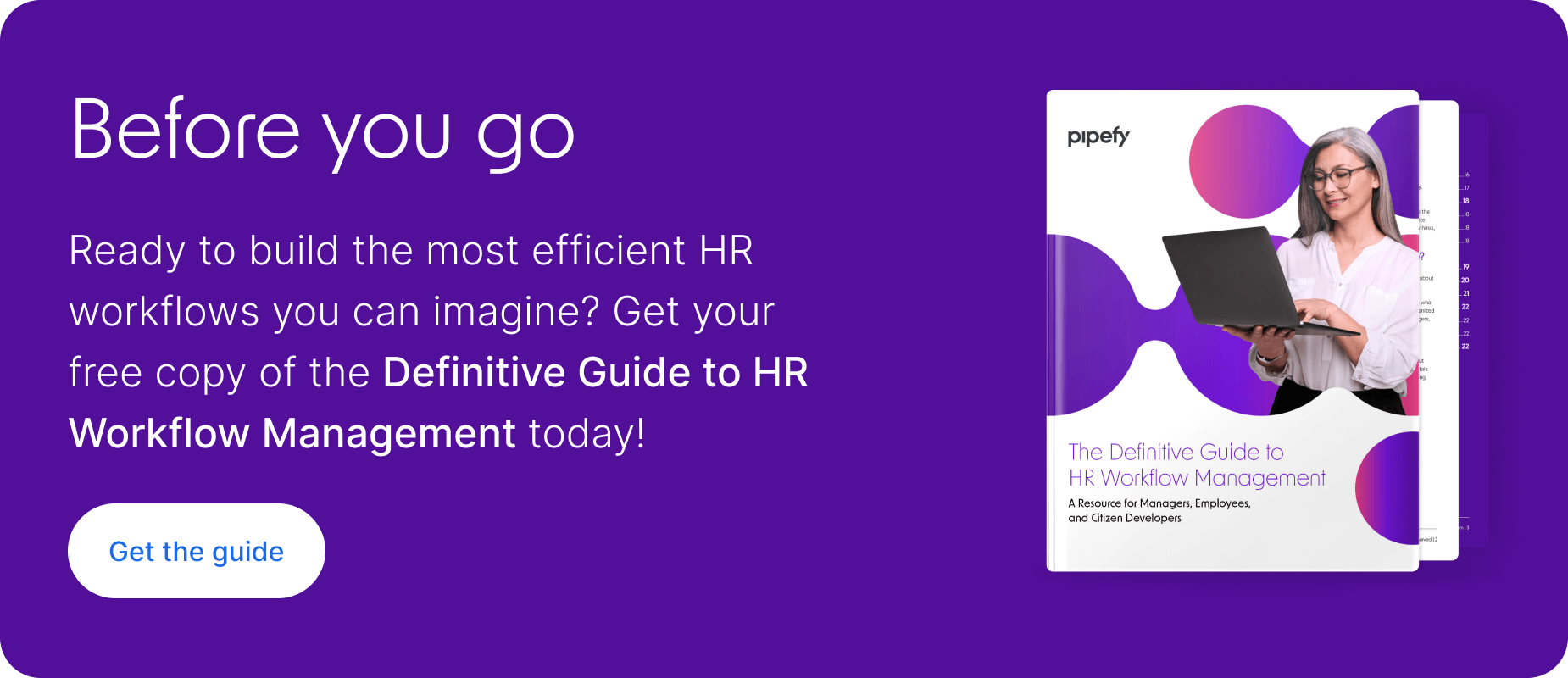
A well-structured employee onboarding process is crucial to fostering a positive experience for new employees. It’s HR’s responsibility to provide a smooth process to represent your organization’s culture, introduce new and existing employees, and ensure new employees start their first days off right.
That’s why it’s important to pay attention to your onboarding workflow because it depends on validations and checkpoints with other teams, such as IT, Finance, and others. The more spread out employee information is spread in different places, the more cumbersome this workflow becomes.
In this article, we will take a step-by-step look at the onboarding process in Pipefy and understand how to efficiently implement it for your organization.
Starting employee journeys the right way
Employee onboarding is the final chapter of the recruitment process, as it welcomes your final candidate into your company. The onboarding process includes gathering key documents, integrating the new employee into their team, and guaranteeing they have access to all the company’s software and equipment.
Successful onboarding is critical for both company and employees. For the organization, it’s important the employee feels welcomed and assimilated into all the new information as soon as possible. For the employee, it’s essential to be well-oriented and trained in the first weeks, so you don’t lose motivation or become discouraged.
The first impression is the last impression — especially when it comes to onboarding. If the process is disorganized, confused, or unable to generate the proper engagement, these negative experiences will likely cause professionals to search for a more welcoming and structured environment. To avoid this scenario, it is necessary to closely address HR’s pains.
How to face onboarding’s most common challenges
With the rise of hybrid and remote working models, the challenges of onboarding have become a little more complex. As it’s a process that involves several departments (HR, IT, Finance), it is crucial that all parties are always in sync and shared information is traceable.
The most common pain points of employee onboarding include:
- No clear deadline tracking
- Lack of standardization in received information
- Lack of visibility of employees’ onboarding status
- Repetitive manual work and constant checks with other teams
- Communication spread across different channels making traceability difficult
To solve such problems (and automate a large part of the operation by integrating with other systems such as ATS, HRMS and ERPs software), it’s necessary to have a dedicated platform for onboarding.
By onboarding with Pipefy, HR departments get:
- Standardization. The correct steps are followed by everyone involved with a clear and defined structure, avoiding lost information (such as employees who do not have access to emails, software, and equipment).
- Scalability with automation. Scale employee onboarding without losing human touch that is so essential to this process. Focus on human contact, and let manual work be automated.
- Integration with processes and systems. Connect related processes to share data among them and integrate other platforms for a continuous, centralized flow.
In addition to these benefits, by having a well-structured and digitized employee onboarding process, the HR team can better monitor statuses and metrics, with easy access to historical information so that onboarding is continuously improved.
| What our customers are saying: “The modernization [of the onboarding] process has brought improvements not only for us, but also for the first impressions about the company. Making new employees feel welcome is crucial to make them feel at home.” Neila Nascimento, tech recruiter at VTEX |
Employee onboarding tutorial: Build an efficient onboarding process
In the Pipefy Template Gallery, you will find a template for employee onboarding that works as a starting point for further customization. This flowchart represents part of this basic template, with some additions:

Remember that this is the beginning of a simpler version of what an onboarding flow can look like inside Pipefy — it all depends on the needs and complexity of your process.
Before moving in, it is important to emphasize that onboarding is divided into two stages: administrative and training. In the first, the focus is on what happens prior to arrival (documentation and signatures) and involves collaboration between teams, while the second is focused on the integration and development of the employee, in which HR introduces the employee to the company’s culture and prepares them for their first steps.
In the example we will analyze, we talk about these two stages within a single continuous flow. In addition, we mainly cover remote and digital onboarding of employees, but the steps mentioned here are also used in face-to-face onboarding.
Stage 1: Documentation
The onboarding process starts long before an employee actually enters the company, as it is necessary to gather a series of documents, review them carefully, and, in the case of remote work, send the equipment to the employee before day one. With a well-defined onboarding checklist, it’s easy to follow every step.
Once the candidate passes through recruiting (which is connected to onboarding), it’s time to handle the legal issues of hiring. Gathering documents can take time, especially if communication with people is not efficient, is decentralized, and if there is no standardized way to receive information. Therefore, the need for a dedicated HR system is already evident.
One card for each new employee
In Pipefy and specifically for this process, each candidate is represented by a card. The card is displayed on a Kanban board and is moved (automatically or manually) through the phases of the process until its completion. Whenever a new card is created, it falls into the first phase of the process, which in onboarding is Documentation — which you can change if you want.
There are a few ways to create cards in Pipefy:
- Public Form: Share an external form with the HR team and team leaders for them to enter employee registration data. The form has mandatory and conditional fields (which appear and disappear according to answers), ensuring essential data is collected. This makes the process flow more smoothly, which increases employee retention and productivity during their first months.
- Integrations: Integrate Pipefy with other HRM software. This way, every time a new registration is created in platforms like BambooHR, Peoplesoft, and others, a new card is created in Pipefy.
- Connections: Connect other HR processes with employee onboarding. For example, when a candidate passes the recruiting process, a card is created in the onboarding process.

Regardless of how inputting a new employee is carried out, the card must follow the steps of the process established by you. This ensures you get control and visibility with easy access in one place.
Automatic and dynamic emails
A great ally in communication with employees is email automation. With Pipefy, you can automate email sending, which means that emails are sent automatically according to your rules, with fields dynamically filled in for each employee.
All you have to do is define the trigger, create the email template, and configure which fields are pre-populated with employee data. For example, in the Documentation phase, we want to receive different documents from the employee and ensure that they were all sent correctly.
It’s possible to set an email template up so every time a new card is created, an email is sent to the employee requesting documents such as ID, residence, etc. All this information is tied to the card and continues through the process.
? Tip: You can build a phase form and share the link with the employee. This way, the person will access it and upload documents directly on the form, which in turn will link it to the phase in which the card is. Thus, all desired information is correctly sent.
Stage 2: Document verification and review
When an employee sends documents, it is needed to verify if the information is correct. Then, it’s time for HR to draw up the contract, talk about the contract type, and sign documents.
This is where the employment contract is signed. Therefore, all of the employee’s doubts must be clarified, such as questions about vacations, days off, working hours, dress rules, the confidentiality of information, among others.
Automatically assigning team members
In Pipefy, you can create rules to automatically assign an HR analyst to each employee, according to the criteria you define. For example, whenever a limited-time contract is carried out, Anne is responsible for the task, but when it’s a traditional contract, John is the one who should handle the onboarding preparation.
In the absence of any document, the employee must be informed (which can be done via email within the card itself), and the card can be moved to the Review phase until the data is correct.
Automatically sending contracts and digital signatures
In a digital hiring process, the contract is sent by email. It is possible to integrate Pipefy with eSignature software such as DocuSign to send and receive the contract directly from the employee’s card to ensure centralization.
Of course, before sending the contract, compensation must be previously agreed with the manager and the Finance team responsible for the department’s budget. If there is still a need for more negotiation, all communication can be done through Pipefy, directly on the employee’s card, with comments and emails exchanged between the internal team.
Stage 3: Equipment
After the contract is signed, it’s time to request the shipment of equipment, such as headphones, a mouse, and notebooks. This is where the IT team comes into play and must analyze the needs of the new employee based on their team and position.
For example, for Design teams, it is necessary to send specific computers for the team’s demands, while Engineering teams may need more robust machines. Other activities of the IT team also happen here, such as creating the employee’s email and giving access to all the company’s software.
Databases
With Pipefy databases, you can create a library with all products owned by the company. This way, the IT team can select one of the available equipment in the database list, which is automatically updated when the employee’s card is moved from phase to phase.
This is just an example of how a database can be used. Another very common use is to turn it into an internal employee record so that all company member information is easily found. This way, whenever employee requests are opened, you already have all the data.

Integrations
Again, it is possible to integrate Pipefy with external platforms of your choice — and it can be extremely helpful. For example, with Zendesk, equipment registration tickets can be performed directly on Pipefy. If the IT team does not have access to Pipefy, this is not a problem, as you can integrate it as you like with other systems.
Stage 4: First week and first month
An employee’s first day is when the onboarding actually begins for them, and it is up to HR to ensure the flood of information they will receive is properly digested. Whichever company you work for, a few steps here are mandatory regardless of the size or field of the organization.
Every onboarding process should have meetings scheduled with leaders, the IT team, and HR (at the very least). Whether digital or face-to-face, onboarding is usually done in small groups and followed by training. Training, in turn, involves introducing the tools used by the company and the organization’s own product/service.
HR’s responsibility is to provide the best welcome experience, introducing the employee in person or digitally. An HR analyst should prepare the itinerary for the first days and carry out follow-ups to motivate and make a great first impression.
| What our customers are saying: “Our teams can see how many employees will start on a certain date, and this makes it even easier to control inventory and schedule deliveries. So everything is set when the new employee arrives.” Neila Nascimento, tech recruiter at VTEX |
Easily schedule meetings
Integrate Pipefy with Google Calendar and schedule all meetings directly on the employee’s card. This way, it is much easier to create all the necessary events and notify involved ones, centralizing the information in the onboarding process.
No deadlines left behind
Create deadline alerts in Pipefy and visualize which phase each employee is at. This way you automatically notify the team as necessary. Furthermore, it is possible to create automations based on dates. For example, when the onboarding date reaches its end, the card is automatically moved to the feedback phase and the employee receives a form.

Stage 5: Onboarding evaluation
After completing onboarding, it’s time to identify what can be improved by asking for an evaluation. We recommend sending a satisfaction survey about the initial experience, with questions about the effectiveness of the training, duration of meetings, materials used, onboarding score, and other comments.
Even after completing onboarding, new employees are still in the adaptation phase and, therefore, it is suggested to perform follow-ups in the next three months. In this phase, you may also want to directly involve the department manager who will continually check on the employee’s experience month after month.
Gathering feedback
It is possible and encouraged to send an automatic email to each employee who completes the onboarding with email templates. In this email, you can include a link to a public phase form, and include in it any questions you want to know about the employee’s experience. Thus, the answers are sent directly to the collaborator’s card.
Connected processes
As we mentioned, the adaptation period is much longer than the first few days, so it is important to follow up with employees. Direct managers normally carries out this monitoring, and it is a process that can be connected to onboarding. This way, employee information is shared between processes, ensuring visibility and centralization.
Keep an eye on onboarding success metrics
Measuring the success of onboarding is essential to improving the process. So make sure you correctly define the data you want to analyze to boost your employees’ experience. See what metrics you can’t miss:
- Employee retention. Increased turnover is something no company wants. Keep an eye on which employees are leaving the company to identify possible root causes.
- Employee satisfaction. Through anonymous forms, establish a level of employee satisfaction and identify how new employees feel about the company.
- Retention by manager. Just like overall turnover, look at the turnover rate of specific teams to identify what is pushing people away or retaining more.
- Training and engagement. Check if people actually engaged in onboarding, if they consumed the materials, watched the videos, and completed the training sessions.
These are some of the most common examples, but it is worth paying attention to other metrics that may be more specific to your organization’s scenario, such as the level of adherence to certain tools, for example.
Dashboards and reports
Within Pipefy, build dashboards to measure the metrics you want, create charts in the form of tables, bars, pie charts, and more. No coding knowledge is required to add or remove charts, as well as to create custom reports. This guarantees autonomy in data analysis and operation speed.
With reports, you can extract data in table format from onboarding and even export it to XLS in Excel. Therefore, it is easy to see how many onboarding sessions were completed per department, the number of new employees, contract types, and more.
Onboarding process best practices
When we talk about an efficient, agile process that saves HR time while maintaining a personal and close touch with people, it’s essential to have a proper flow established. The best onboarding processes have each of the following:
- An automated process that acts as a single source of information for all departments involved (HR, IT, Finance, and others).
- An error-proof digitized process that ensures efficiency and compliance, providing alignment between teams and a positive experience.
- Consistency and standardization throughout the entire process allow data to be analyzed on an equal footing, regardless of the employee.
- Onboarding is a relationship and not just a process, as it is necessary to ensure that the employee has made the correct choice and will be well received.
- It’s HR’s (and the manager’s) role to keep people engaged and aware, so consistently checking in with new employees is essential to supporting them during the adaptation period.
Pipefy is the employee onboarding platform that leverages HR teams with an easily automated and standardized process. Employees, candidates, managers, and different teams benefit from an organized and integrated flow. Inspire confidence and make your new employees feel at home on day one with a flawless onboarding experience.










